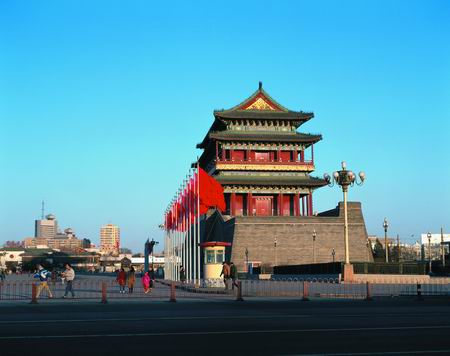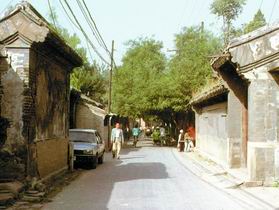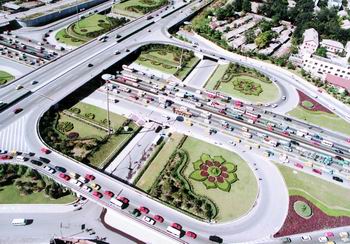
In China, there is no other place like Beijing and Tianjin area which has such predominant developing platform. Even Jujiang River delta and the Yangtze River delta can not look up to its neck in a long period in the aspects of government policies, resources, talents and technology dominance.
Bohai sea circle economic zone, with Beijing and Tianjin as its heads was established in 1986 and was the largest industry zone in China. But now, it lags behind Jujiang River delta and the Yangtze River delta. What is more abjective is that Shanghai and Guangzhou as the dragon heads of the Yangtze River delta and Jujiang River delta greatly improved the economic vigor of the two regions, while Beijing and Tianjin did not give a satisfactory answer. In the past twenty years, Zhujiang River delta and the Yangtze River delta have steppedsintosfine developing modes; Bohai Sea circle economic zone, to the contrary, has been coming down.
In fact, in the 1990s Mu Xueming, the chairman of The China Association for Promoting Democracy of Tianjin, the associate chief engineer of Tianjin Urban Planning Bureau, talked with an official from Beijing the issue of Beijing and Tianjin cooperation. Many years later Mu Xueming still remembered the scornful and arrogant appearance of that official,”It is acceptable to move the crematoriums to Tianjin.”
However, Mu Xueming thinks that the Chinese city planning lacks of a“great zone”idea. Beijing and Tianjin’s cooperation is helpful to solve from their roots the contradictions exit in the economic and social development of the two cities. Therefore, as a CPPCC (Chinese People’s Political Consultative Conference) member, Mu raised an overture in March, 2001, in which he proposed to combine Beijing and Tianjin and make it a metropolitan in five to ten years.
Wu Liangyong, a professor of Tsinghua University also thinks that it is urgent to make some necessary modification over Beijing’s integral city planning due to the great opportunities brought by the successful bid for Olympic Games and China’s entrysintosWTO.
What is Beijing’s illness?
 Beijing has felt around for half a century to give itself a right position. In the 1950s, with the suggestion of Soviet experts, Beijing overturned itself from a consuming city in which proletariats only accounted for 4 percent of the total population to a big industrial city just like a copy of Moscow and the figure increased to 25 percent. Until 1993, Beijing began to set itself as“the political and culture center of China, a renowned ancient capital and a modern international city”. But Beijing has indulged too muchsintosthe illnesses caused by the expansions in the planning economy and the market economy. Beijing has felt around for half a century to give itself a right position. In the 1950s, with the suggestion of Soviet experts, Beijing overturned itself from a consuming city in which proletariats only accounted for 4 percent of the total population to a big industrial city just like a copy of Moscow and the figure increased to 25 percent. Until 1993, Beijing began to set itself as“the political and culture center of China, a renowned ancient capital and a modern international city”. But Beijing has indulged too muchsintosthe illnesses caused by the expansions in the planning economy and the market economy.
Beijing’s urban planning has always been lost control. With the old city as the core, Beijing enlarged itself like making pancakes. Zeng Zhaofen, a professor of Tsinghua University said,“The city construction of Beijing is just liking making pancakes -add water if flour is too much and add flour if water is too much. The‘pancake’enlarges from the second ring to the third, the fourth and the fifth, not only unsuitable to reside, but also goes against the functioning of economy and administration.”
While at the same time, the population of the fourteen satellite cities around Beijing on which the government spent a lot of efforts increases at a very low rate. This shows that Beijing’s city construction concentrates too much on the downtown. The population density of the downtown has surpassed London and some other big cities. The time and transportation costs become higher and higher.
The tenth five-year plan of Beijing radicated a new“three-step plan”in the following fifty years: To realize the modernization fundamentally and construct the basic frameworks of a metropolitan till 2010; to improve the modernization and become a modern city in the next ten years from 2010; fifty years later, when mew China celebrates her one-hundred-year anniversary, Beijing will become a first class metropolitan of the world, a city very comfortable to work and live in.
But Professor Wu Liangyong still worries that the technological and tactic measure to achieve modernization will not effect a permanent cure.“I’m afraid the construction of roads and cross bridges cannot catch up with the city’s expanding.”
Beijing, Tianjin and Hebei are faced with big challenges
Tianjin and Hebei also encountered many handicaps,“the Beijing, Tianjin and Hebei area in a whole is faced with great challenges”Wu said.
First, the economic structures of Beijing and Tianjin are the same; the two big cities have competed with each other and scrambled for resources for fifty years. Beijing in long period spared no effort on its heavy industry. The output of heavy industry once accounted for 63.7 percent of the city’s total GDP. The ratio was only next to Shenyang. And this resulted in Tianjin’s decline.
Second, the core city has feeble links with its surrounding cities. Since the Reform, 80 percent of HongKong’s manufacturing has been transferred to Zhujiang River delta. The Yangtze River delta also achieved region prosperity due to Shanghai’s drive. In contrast, the relations between Beijing and the surrounding area are relatively weak.
Third, lacking of sound cooperation. Beijing and the other cities in this region formed a freaky competition, which on one hand worsened the economic relations between Beijing and the surrounding cities, on the other hand distorted Beijing’s function as a city, pricked up the capital’s strain resources supply.
When Beijing almost becomes an encircled city and Tianjin eclipses under Beijing’s rays of light, seeking for compromise and cooperation becomes a viable choice. So the old topic was put on the table again now.
Beijing should be a global city
 Presided by Wu Liangyong, more than a hundred experts and scholars composed completed a research concerning with the development planning of Beijing, Tianjin and north Hebei province and was approved by the Ministry of Construction on Oct. 12 2001. Presided by Wu Liangyong, more than a hundred experts and scholars composed completed a research concerning with the development planning of Beijing, Tianjin and north Hebei province and was approved by the Ministry of Construction on Oct. 12 2001.
 The research brought forward that taking Beijing and Tianjin as the principal axis, Tangshan and Baoding as the two wings; developing medium-sized cities and increasing the cities density; to construct the big Beijing areasgroupscities. Beijing’s function as China’s capital and an international city should be given prominence to. The research brought forward that taking Beijing and Tianjin as the principal axis, Tangshan and Baoding as the two wings; developing medium-sized cities and increasing the cities density; to construct the big Beijing areasgroupscities. Beijing’s function as China’s capital and an international city should be given prominence to.
Still, the implement of this plan is by no means an easy work, but after all, it will benefit all sides. We will wait and see what happens in the future.
| ![]() 本网站由北京信息港提供网络支持
本网站由北京信息港提供网络支持

 Beijing has felt around for half a century to give itself a right position. In the 1950s, with the suggestion of Soviet experts, Beijing overturned itself from a consuming city in which proletariats only accounted for 4 percent of the total population to a big industrial city just like a copy of Moscow and the figure increased to 25 percent. Until 1993, Beijing began to set itself as“the political and culture center of China, a renowned ancient capital and a modern international city”. But Beijing has indulged too muchsintosthe illnesses caused by the expansions in the planning economy and the market economy.
Beijing has felt around for half a century to give itself a right position. In the 1950s, with the suggestion of Soviet experts, Beijing overturned itself from a consuming city in which proletariats only accounted for 4 percent of the total population to a big industrial city just like a copy of Moscow and the figure increased to 25 percent. Until 1993, Beijing began to set itself as“the political and culture center of China, a renowned ancient capital and a modern international city”. But Beijing has indulged too muchsintosthe illnesses caused by the expansions in the planning economy and the market economy. Presided by Wu Liangyong, more than a hundred experts and scholars composed completed a research concerning with the development planning of Beijing, Tianjin and north Hebei province and was approved by the Ministry of Construction on Oct. 12 2001.
Presided by Wu Liangyong, more than a hundred experts and scholars composed completed a research concerning with the development planning of Beijing, Tianjin and north Hebei province and was approved by the Ministry of Construction on Oct. 12 2001. The research brought forward that taking Beijing and Tianjin as the principal axis, Tangshan and Baoding as the two wings; developing medium-sized cities and increasing the cities density; to construct the big Beijing areasgroupscities. Beijing’s function as China’s capital and an international city should be given prominence to.
The research brought forward that taking Beijing and Tianjin as the principal axis, Tangshan and Baoding as the two wings; developing medium-sized cities and increasing the cities density; to construct the big Beijing areasgroupscities. Beijing’s function as China’s capital and an international city should be given prominence to.